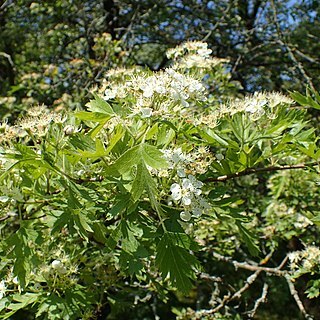Shrubs or small trees, 4–5 m tall, armed or unarmed; thorny 0.8–1.5 cm, stout. Branchlets purplish brown when young, grayish brown when old, initially sparsely pubescent, soon glabrate, terete; buds reddish brown, ovoid, glabrous. Stipules falcate or lanceolate, ca. 8 mm, herbaceous, glabrous, margin serrate, apex acuminate; petiole 2–2.5 cm, glabrous or subglabrous; leaf blade rhomboidal-ovate to broadly ovate, 3.5–6.5 × 2.5–5.5 cm, both surfaces pubescent when young, glabrescent, base cuneate, rarely broadly cuneate, margin remotely serrate and with 2 or 3 pairs of deep lobes, or apically shallowly lobed; lobes oblong, apex acute. Corymb 3–5 cm in diam., many flowered; peduncle glabrous or slightly pubescent when young; bracts caducous, linear, membranous. Pedicel 0.5–1.5 cm, slightly pubescent when young. Hypanthium campanulate, initially pubescent, soon glabrous. Sepals triangular-ovate or broadly lanceolate, ca. 3 mm, abaxially initially pubescent, glabrescent. Petals not seen. Stamens 15–20. Ovary pubescent apically, 2-or 3-loculed, with 2 ovules per locule; styles 2 or 3. Pome reddish black with yellow pulp, sparsely punctate, globose, rarely ellipsoid, 1.2–1.6 cm in diam., glabrous; sepals persistent, reflexed; pyrenes 2 or 3, smooth on both inner sides. Fl. May, fr. Jul. 2n = 68*.
More
A large shrub or small tree. It has many trunks. These are 5-9 cm across. The bark is reddish-grey. It splits and peels off in thin strips. The leaves are widely oval and slightly hairy. There are 5-9 unequal lobes. The base is wedge shaped. There are 28-35 flowers in a group. The flowers are 1.8 cm across. They have densely hairy stalks. The fruit are widely oval. They are 1.3 cm long by 1 cm wide. They are dark red with orange, sweet flesh. They are edible. Each fruit has 2-3 seeds.
River valleys and ravine slopes in the mid-mountain zone. Valleys and thickets at elevations of 500-2000 metres in Tibet. Limestone and granite soils on mountain slopes, in woodlands and by rivers; at elevations from 800-2,700 metres.
More
Temperate. In Kazakhstan it grows on rocky slopes in the middle mountain regions. In western China it grows between 500-2,000 m above sea level.


